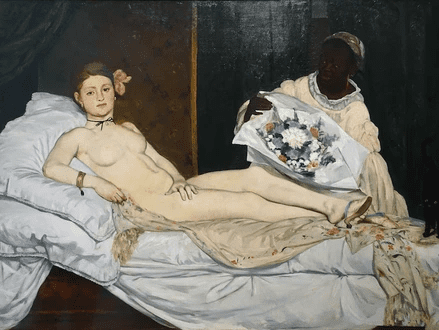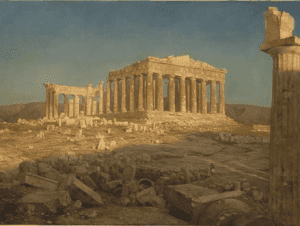What are the top ten most famous painting in the world?
This is something all artists should know, you don’t need to know every detail about them, but here is some information about the 10 most famous paintings of all time.
10. Olympia

Edouard Manet’s painting Olympia caused quite a stir because it depicted a naked woman with a look and that subtlety suggested she was a mistress. It’s also a clear example of the realism style from the beginning.
Manet picked a well-known artwork in the Louvre collection as his source—Venus of Urbino, a 1538 painting by Venetian Renaissance artist Titian—as if to emphasise his rejection of the past. He then deprived it of its significance. Olympia was plainly not a reverent homage to Titian’s masterwork to a classically educated eye; instead, the artist provided an inferior replica. Olympia was bluntly painted, badly contoured, lacked depth, and looked to inhabit the seamy, modern world of Parisian prostitution in place of the smoothly moulded sensuous figure of Venus, situated inside a wonderfully atmospheric and mythical environment.
9. The Scream

The Scream is a painting by Norwegian artist Edvard Munch that depicts a man with a distorted face against a bloody sky. The hilly terrain in the background adds to the appeal of this photograph. It’s also one of the first paintings in the expressionism style, in which reality is blurred to emphasise emotions.
The Scream is essentially autobiographical, an expressionistic production based on Munch’s true experience of a scream piercing through nature while on a stroll, after his two friends, who can be seen in the background, had left him. Munch represents the sound in a way that, if taken to extremes, can destroy human integrity, fitting the reality that it must have been heard when his mind was in an aberrant state. Munch was well aware of the dangers of such work for a neurotic humanist like himself, according to several data. He quickly abandoned the technique and rarely, if ever, exposed a foreground figure to such extreme and systematic deformation again.
All About The Scream by Edvard Munch
8. Water Lilies

Claude Monet’s Water Lilies is a collection of 250 oil paintings focused on his own flower garden. These works can be found in a variety of art museums around the world.
Water Lilies is the name of a group of paintings rather than a single artwork. Claude Monet returned to this subject matter multiple times during his lifetime, producing over 250 water lily paintings. Water Lilies, together with Vincent van Gogh’s Starry Night, are the most famous Impressionist pictures. Monet concentrates on the water’s surface in all of his “Water Lilies” works. He doesn’t portray the land or the sky, instead of focusing on their reflection in the water. Willows are only visible as a reflection in these paintings, which are common. The sky, with its white clouds, reflects in the water, making the sky and the water one colour.
7. Starry Night

Vincent Van Gogh’s painting Starry Night depicts the village of Saint-Remy in a spinning light. It is currently located in the Museum of Modern Art in New York and is one of the most well-known photographs of modern culture.
The Starry Night (created in mid-June) is both an exercise in observation and a distinct departure from it, since it was inspired by the view from his window at the Saint-Paul-de-Mausole institution in Saint-Rémy, in southern France, where the artist spent twelve months in 1889–90 seeking refuge from his mental disorders. Despite the fact that the vision occurred at night, the painting, which was one of hundreds painted by van Gogh that year, was done in multiple sessions throughout the day, under very different climatic circumstances. The charming town hidden among the hills was based on other views—it couldn’t be seen from his window—and the cypress on the left seems much closer than it actually was.
6. The Creation of Adam

Michelangelo’s The Creation of Adam depicts God’s creation of Adam. It is one of the paintings that adorn the Sistine Chapel’s 12,000 square feet of space in Vatican City.
The Creation of Adam, out of all the magnificent pictures that adorn the Sistine Ceiling’s vast complex, is without a doubt the one that has left the most lasting impression on posterity. No surprise, for we are given a single stunning image of God’s sublimity and man’s potential nobility that is unparalleled in the history of visual art. The Lord glides over the sky, His cloak wide and overflowing with heavenly forms, and His serene gaze accompanying and reinforcing the movement of His strong arm, no longer standing on earth with closed eyes and mantle.
5. The Last Supper

The Last Supper is a painting depicting Jesus’s last meal with his disciples. This painting, which is on display in the dining hall of Santa Maria delle Grazie in Milan, has sparked a lot of debate about Mary Magdalene, the supposed character sitting next to Jesus.
The picture is well-known for depicting Jesus’ final lunch with his apostles before he was arrested and killed. But, more importantly, Leonardo da Vinci intended to represent the moment when Jesus discloses that one of his companions will betray him, replete with the apostles’ shock and wrath. According to Leonardo da Vinci’s perspective, the scene takes place right before the Eucharist’s birth, with Jesus reaching for the bread and a glass of wine that would become the sacrament’s essential emblems.
All About The High Renaissance
4. Girl with a Pearl Earring

The Girl With a Pearl Earring is also known as Dutch Monalisa due to the girl’s difficult-to-understand voice. Her pearl earrings are the focal point of this painting by Johannes Vermeer.
Vermeer was not generally recognised outside of his own city of Delft during his lifetime or in the decades after his death, despite the fact that he is now considered as a highly acclaimed artist. Historians credit the 19th-century French critic Étienne-Joseph-Théophile-Thoré (as William Bürger) for reassessing the artist’s work, which led to Vermeer’s illustrious reputation. Despite this, Girl with a Pearl Earring did not become one of Vermeer’s most well-known works until the turn of the century, following a blockbuster show at the National Gallery of Art in Washington, D.C. in 1995 and the release of Tracy Chevalier’s best-selling novel Girl with a Pearl Earring in 1999.
3. Night Watch

Rembrandt’s Night Watch is one of his most well-known works. It portrays the evacuation of an entire area, led by its captain. Its dark varnish, which gives the appearance of a night scene, is one of its distinguishing features. It is currently on display at Amsterdam’s Riksmuseum.
One of the three headquarters of Amsterdam’s civic guard was the subject of Rembrandt’s largest and most renowned painting. The city was defended by these units of citizen troops. Rembrandt was the first to paint a civic guard work with all of the figures in action. The captain, clothed in black, issues the marching order. The guardsmen are forming their lines. The light was utilised by Rembrandt to draw attention to certain aspects, such as the captain’s waving hand and the little child in the foreground. She was the mascot for the firm. Night Watch was given to the picture long later, when it was considered to depict a night setting.
2. School of Athens

This painting, painted by Raphael, depicts famous philosophers like Plato and Aristotle walking in the centre, with other philosophers on the sides. It has now been moved to the Vatican.
The School of Athens is a masterwork that aesthetically communicates an academic subject, set in an enormous architectural illusion painted by Raphael. Raphael employed groups of characters in one picture to lay out a comprehensive lecture on the history of philosophy and the many ideas espoused by famous Greek philosophers.
Private showings of the Sistine Chapel in progress, organised by Bramante, would almost definitely have been known to Raphael. Though Raphael’s work is more intricate in many aspects because to the large number of individuals in a single scene, he was clearly influenced by the great artist’s work.
1. Mona Lisa

Mona Lisa by Leonardo da Vinci is perhaps the most famous painting in the world. It’s a portrait of a lady named Gherardini, and it’s popular for the lady’s indecipherable speech. This painting is on display at the Louvre in Paris, France.
Leonardo da Vinci’s Mona Lisa is a half-length portrait painting. It has been called “the most known, the most visited, the most written about, the most parodied work of art in the world.”
Everyone in the world knows of this painting, whether you are an art lover or not.
Why Is Mona Lisa Painting So Famous?
Information Citations
En.wikipedia.org, https://en.wikipedia.org/.
Recommend0 recommendationsPublished in Art History, Resources








Responses